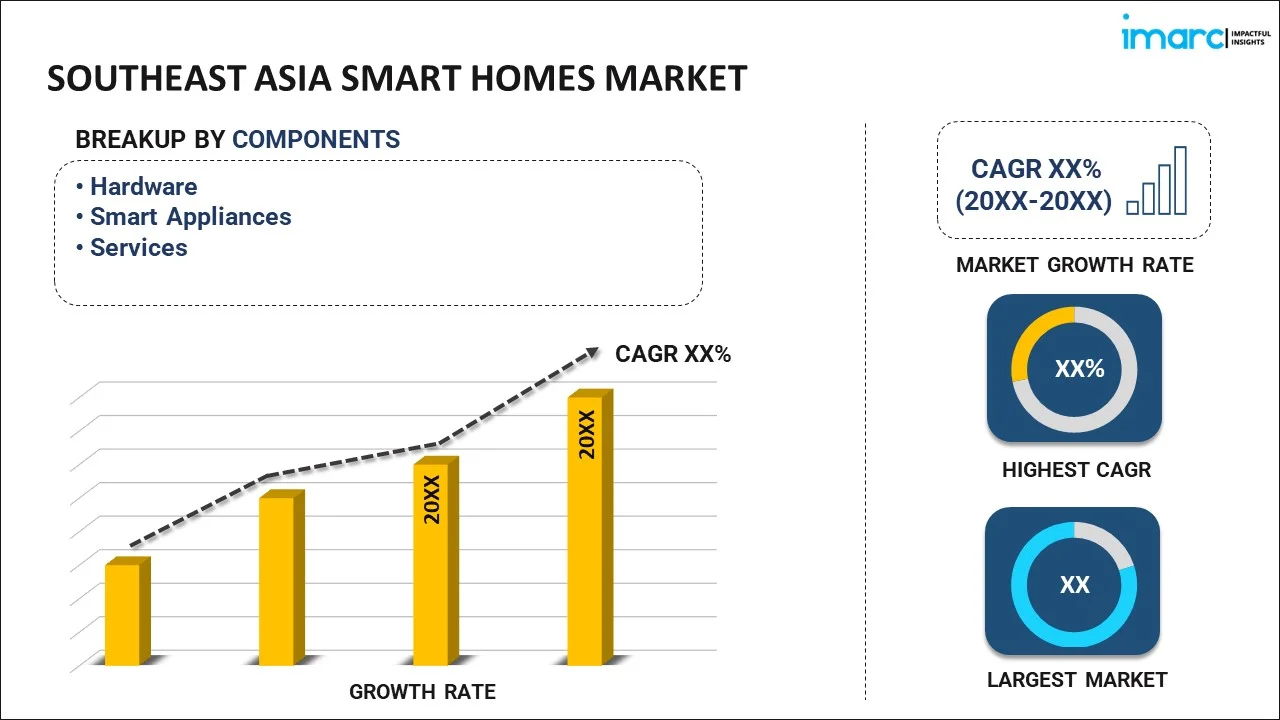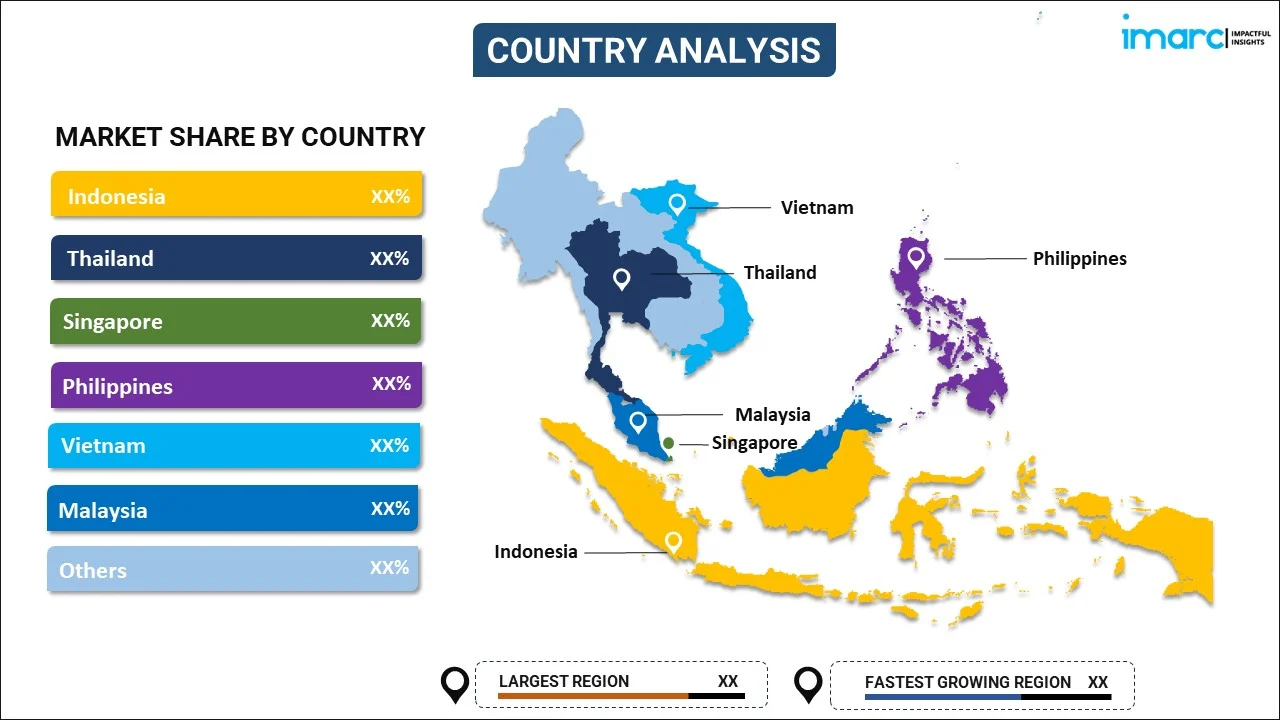
Southeast Asia Smart Homes Market Report by Component (Hardware, Smart Appliances, Services), Application (Security and Surveillance, Lighting, Entertainment, Energy Management, HVAC, Smart Kitchen, Home Fitness and Wellness), and Country 2025-2033
Market Overview:
Southeast Asia smart homes market size is projected to exhibit a growth rate (CAGR) of 21.09% during 2025-2033. The rising demand for convenience and streamlined living experiences, along with the increasing consumer consciousness among individuals towards energy efficiency and sustainability, is primarily driving the market growth.
|
Report Attribute
|
Key Statistics
|
|---|---|
|
Base Year
|
2024 |
|
Forecast Years
|
2025-2033
|
|
Historical Years
|
2019-2024
|
| Market Growth Rate (2025-2033) | 21.09% |
Smart homes denote dwellings integrated with sophisticated technologies that facilitate the automation, regulation, and interconnection of diverse devices and systems. Leveraging the capabilities of the Internet of Things (IoT), they empower homeowners with the capacity to remotely oversee appliances, lighting, security, and heating, commonly through smartphone applications or voice-operated commands. This technological integration augments convenience, energy conservation, and safety by establishing a seamlessly interconnected environment where devices can communicate and adjust in accordance with the preferences of the residents. The primary objective of smart homes is to streamline daily chores, enhance comfort, and deliver a more personalized living experience by incorporating contemporary technology into various facets of domestic life.
Southeast Asia Smart Homes Market Trends:
The Southeast Asia smart homes market is driven by the integration of Internet of Things (IoT) devices and the increasing preference for seamless connectivity within residential spaces. As consumers increasingly prioritize enhanced convenience, remote management capabilities, and energy efficiency, the ability to oversee and regulate appliances, lighting systems, security setups, and more through smartphones and voice-operated commands is garnering significant momentum on a wide scale. Furthermore, the mounting emphasis on sustainability and energy preservation has expedited the uptake of smart home solutions that offer effective energy administration and reduced consumption, catering to the growing demand for eco-friendly living options within the region. Additionally, the escalating aging population and the amplified requirement for independent living solutions have spurred the demand for smart home technologies that bolster safety measures and facilitate day-to-day activities for elderly residents. The ongoing advancements in artificial intelligence (AI), machine learning (ML), and voice recognition technology have further enhanced the overall user experience, fostering more intuitive and personalized interactions with smart devices, thereby serving as a key catalyst for the expansion of the market. Furthermore, the increasing awareness regarding the diverse benefits of home automation, coupled with competitive pricing strategies and the continuous expansion of product offerings, is anticipated to contribute to the overall growth trajectory of the smart homes market in Southeast Asia over the forecasted period.
Southeast Asia Smart Homes Market Segmentation:
IMARC Group provides an analysis of the key trends in each segment of the market, along with forecasts at the regional and country levels for 2025-2033. Our report has categorized the market based on component and application.
Component Insights:

- Hardware
- Security
- Home Automation
- Home Entertainment
- Home Healthcare
- Smart Appliances
- Services
- Energy Consumption and Management Services
- Security Services
- Healthcare Services
- Entertainment Services
The report has provided a detailed breakup and analysis of the market based on the component. This includes hardware (security, home automation, home entertainment, and home healthcare), smart appliances, and services (energy consumption and management services, security services, healthcare services, and entertainment services).
Application Insights:
- Security and Surveillance
- Lighting
- Entertainment
- Energy Management
- HVAC
- Smart Kitchen
- Home Fitness and Wellness
A detailed breakup and analysis of the market based on the application have also been provided in the report. This includes security and surveillance, lighting, entertainment, energy management, HVAC, smart kitchen, and home fitness and wellness.
Country Insights:

- Indonesia
- Thailand
- Singapore
- Philippines
- Vietnam
- Malaysia
- Others
The report has also provided a comprehensive analysis of all the major regional markets, which include Indonesia, Thailand, Singapore, Philippines, Vietnam, Malaysia, and Others.
Competitive Landscape:
The market research report has also provided a comprehensive analysis of the competitive landscape in the market. Competitive analysis such as market structure, key player positioning, top winning strategies, competitive dashboard, and company evaluation quadrant has been covered in the report. Also, detailed profiles of all major companies have been provided.
Southeast Asia Smart Homes Market Report Coverage:
| Report Features | Details |
|---|---|
| Base Year of the Analysis | 2024 |
| Historical Period | 2019-2024 |
| Forecast Period | 2025-2033 |
| Units | Million USD |
| Scope of the Report | Exploration of Historical and Forecast Trends, Industry Catalysts and Challenges, Segment-Wise Historical and Predictive Market Assessment:
|
| Components Covered |
|
| Applications Covered | Security and Surveillance, Lighting, Entertainment, Energy Management, HVAC, Smart Kitchen, Home Fitness and Wellness |
| Countries Covered | Indonesia, Thailand, Singapore, Philippines, Vietnam, Malaysia, Others |
| Customization Scope | 10% Free Customization |
| Post-Sale Analyst Support | 10-12 Weeks |
| Delivery Format | PDF and Excel through Email (We can also provide the editable version of the report in PPT/Word format on special request) |
Key Questions Answered in This Report:
- How has the Southeast Asia smart homes market performed so far and how will it perform in the coming years?
- What has been the impact of COVID-19 on the Southeast Asia smart homes market?
- What is the breakup of the Southeast Asia smart homes market on the basis of component?
- What is the breakup of the Southeast Asia smart homes market on the basis of application?
- What are the various stages in the value chain of the Southeast Asia smart homes market?
- What are the key driving factors and challenges in the Southeast Asia smart homes?
- What is the structure of the Southeast Asia smart homes market and who are the key players?
- What is the degree of competition in the Southeast Asia smart homes market?
Key Benefits for Stakeholders:
- IMARC’s industry report offers a comprehensive quantitative analysis of various market segments, historical and current market trends, market forecasts, and dynamics of the Southeast Asia smart homes market from 2019-2033.
- The research report provides the latest information on the market drivers, challenges, and opportunities in the Southeast Asia smart homes market.
- Porter's five forces analysis assist stakeholders in assessing the impact of new entrants, competitive rivalry, supplier power, buyer power, and the threat of substitution. It helps stakeholders to analyze the level of competition within the Southeast Asia smart homes industry and its attractiveness.
- Competitive landscape allows stakeholders to understand their competitive environment and provides an insight into the current positions of key players in the market.
Need more help?
- Speak to our experienced analysts for insights on the current market scenarios.
- Include additional segments and countries to customize the report as per your requirement.
- Gain an unparalleled competitive advantage in your domain by understanding how to utilize the report and positively impacting your operations and revenue.
- For further assistance, please connect with our analysts.
 Inquire Before Buying
Inquire Before Buying
 Speak to an Analyst
Speak to an Analyst
 Request Brochure
Request Brochure
 Request Customization
Request Customization




.webp)




.webp)












